So far my blog and video’s has been about DIY tech stuff with a focus on audio. This time we stay in the realm of audio but go back time. Way back even before even I was born, because I would like to show you an old audio device that I saved from the skip somewhere in the 1990’s but was produced in the late fifties early sixties. It even still works (sort of). It’s an old table-top reel to reel tape recorder made by the technology pride of the Netherlands: Philips, more specifically the EL3515A model. This EL series of reel to reel tape recorders have been produced by Philips from 1957 onwards to 1968. But this EL3515A is an early model. The “A” indicates that it is a more luxurious version of the basic EL3515, with a wooden case covered with fake leather instead of a plastic case. It is pre-transistor device and its electronics is still based on radio tubes. One of the tubes is used for the “magic eye” which is in the big stop button, which lights up green when the device is on and should show the recording level. This is one of the first models with such a “magic eye”. The whole package comes in the form of a carrying case that is 370 mm wide, 160mm high and 320 mm deep.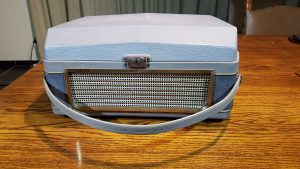
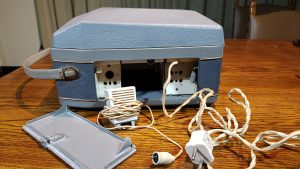
The power cable and a separate mono microphone can be tucked away in a small compartment on the right side of the case with a removable lid. The whole thing has a hefty weight of around 8 kg, mainly because all the electronics and moving part are mounted in a cast-iron frame that resides in the wooden case. Because of this, I would not call it a mobile device. It runs off AC power switchable between 110, 127, 220 and 245 Volts. It is a mono device with around 2-2.5 Watts output. When you remove the plastic cover, you can see that it uses 9 to 13 inch tape reels. It plays and records two mono tracks (two sides) running at a speed of 9.5 cm/s.
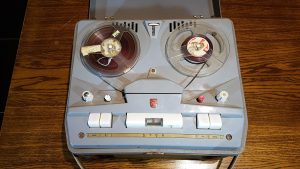
After plugging in the power socket, you can switch it on by turning the left volume button. The whole thing directly springs to life with the hum of the drive motors, but playback can only be heard after a short warm-up until the “magic eye” is at its full intensity. It is very basic machine, the extreme left and right buttons are for winding back and forth, then you have on the left, a pause button, on the right the play button and the big button in the middle with the “magic eye” is the stop button. Between the two reels there is also a counter present, but this is broken on this machine. The turning nobs on the extreme left and right are on/off and volume left and the recording level on the right. The smaller nobs next to them are tone adjustment on the left and the red recording button on the right.
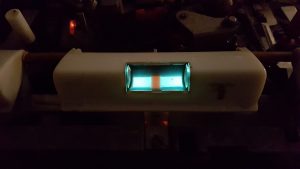
The “magic eye” lighting up in the stop button
When I rescued it from the skip somewhere in the 1990’s, it still worked fine and I used it as a novelty when my little nieces and nephews were visiting to record their voices and playing them back to them. That was always a lot of fun. Now it seems that the amplifier part of the device has deteriorated, playback and recording levels are low. It first off all would need a thoughrough cleaning. As it is now standing in storage, I am thinking to sell it off. Its seems that there are still some enthusiast out there who collect these things or scavenge them for the radio tubes. These tubes seem then to find their way into all kinds of DIY projects. When researching this device for this blog and my youtube video. I also came across an advertisement from the Leidsche courant from 1959 with prices for the EL3515, EL3515A and the more advanced EL3538. The EL3515A was priced at 398 Dutch guilders in 1959, which translates in a value of € 1 219.42 in todays money (Calculated with the tool here.), but I think I will make my asking price as a serious lot lower! If you want to see the EL3515A in action please watch my youtube video below.
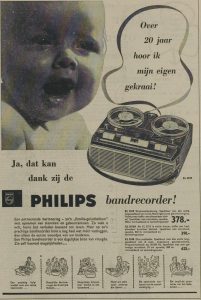
The EL3515A in an Dutch advertisment from 1959

